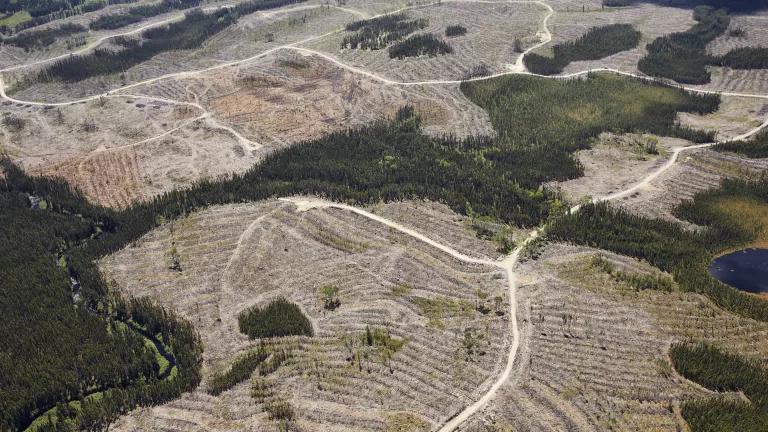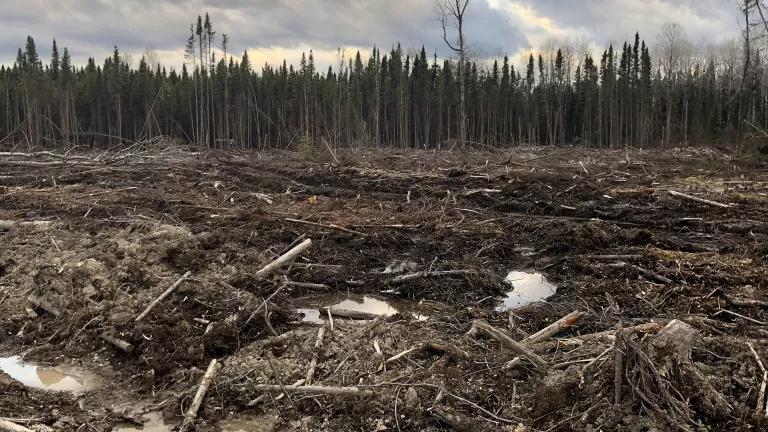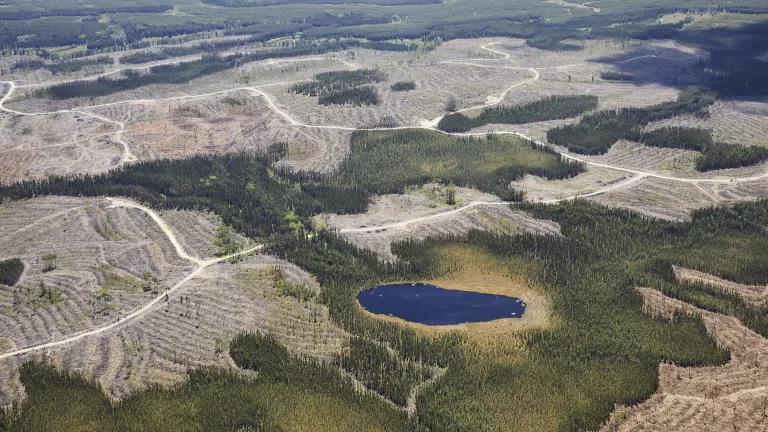The Canadian Logging Industry’s Spin Cycle
The forest products industry is doing everything in its power to normalize the tree-to-toilet pipeline.

Clearcut logging in Ontario
Deny. Minimize. Deflect. These three tactics, most notoriously staples of the tobacco and fossil fuel industries’ playbook, are also strategies the Canadian logging industry has long used to parry criticisms of its environmental impacts. In response to NRDC’s recent Issue with Tissue report, which highlights the impact that the tissue sector’s tree-to-toilet pipeline has on the climate-critical Canadian boreal forest, industry representatives like the Forest Products Association of Canada (FPAC) have once again mobilized spin against science to avoid accountability for their unsustainable practices.
Deny
The industry’s first tactic is to deny that there is anything to worry about at all. Logging in Canada, they claim, is “world-class,” distinct from the forest catastrophe happening in Brazil. But the fact is, the logging industry’s clearcutting and even replanting practices are not centered on ensuring sustainability for the environment, but for ensuring sufficient timber for the industry. In fact, even excluding the impacts of wildfires, Canada has the third-highest intact forest loss in the world, just behind the country whose practices it condemns, Brazil.
The logging industry clearcuts one million acres of boreal forest every year, the impacts of which are well documented. Boreal caribou populations, which serve as a barometer for the forest’s health, have been declining in numbers for decades, primarily due to logging’s impact on their habitat. Indigenous Peoples like the Waswanipi Cree have only a fraction of their intact forests remaining. And industrial clearcutting in the Canadian boreal, which holds twice as much carbon as the world’s oil reserves, is having an immense impact on the climate. Clearcutting is threatening to unleash a Pandora’s box of locked-up carbon and hobbling one of the world’s most climate-critical ecosystems.
Minimize
The second industry tactic is to minimize its role in driving the crisis. In the case of toilet paper, the logging industry’s constant refrain is that logging in Canada’s true purpose is to make long-lived lumber. Tissue, paper, and other short-lived products, the industry claims, are simply prudent means of using the “scraps” left behind in the sawmill. But what the industry frames as merely its discards are actually one of its most significant economic drivers, accounting for 40% of Canada’s revenue from forest products. When a pulp mill recently closed down, leaving a sawmill with nowhere to send its “scraps,” FPAC President Derek Nighbor himself bemoaned the economic ramifications. Pulp mills are not some inert bottom-feeders—they make the whole logging ecosystem in Canada work.
In fact, pulp is so critical to the industry that what they deem “scraps” are, in many cases, not scraps at all. In Ontario, 40 percent of all pulp is made from roundwood—or whole trees—not from chips left on the sawmill floor. And tissue pulp in particular is in greater demand than ever. The logging industry has, like print media, faced the woes of a digital transition, and the tissue sector has been an indispensable area of growth.
Deflect
The logging industry’s other common tactic is deflection—often through pointing the finger at naturally occurring phenomena as the real drivers of forest loss. In the boreal, fire is the primary environmental scapegoat, which industry often portrays as an equivalent disturbance to logging. Industry argues that the forest isn’t actually “ancient” or particularly worthy of protection from a fate in a toilet bowl because fires burn the forest every generation or so anyway. But this is a fire-red herring to steer the conversation away from the egregiousness of the tree-to-toilet pipeline that also belies the wide gulf between natural disturbances and clearcutting.
The boreal is well adapted to the fire regime—not so much to the gnawing steel of mechanical fellers and log loaders, or the miles of logging roads and scarred landscapes left in their wake. A forest as an ecosystem remains a natural, functioning forest ecosystem after a fire, especially given how dependent so many plants and animals actually are to fire’s impacts on the landscape. A roll of toilet paper and the razed forest left in its wake play no such role in the natural forest ecosystem.
And, in eastern Canada, which is a major source of the forest products exported to the United States, fires are far rarer. Forest stands there often go hundreds of years without a fire. Moreover, the increase in fires from climate change only adds to the urgency of protecting intact forests, which are more resilient to natural disturbances than previously logged landscapes.
Policy Implications
The industry’s years of misinformation have, unfortunately, pervaded logging policies across Canada, creating a regulatory structure that too often ignores science in favor of short-term profits. Industrial expansion often happens hastily, while environmental protections remain stalled in an industry-created quagmire. As a result, no province has implemented the required boreal caribou habitat protections under Canada’s Species at Risk Act, and, emboldened by industry’s sway, many are even eroding environmental safeguards that had been in place. Ontario has even rolled back public oversights, jeopardizing democratic checks on industry.
The forest products industry is now doing everything in its power to normalize the tree-to-toilet pipeline and obfuscate both its current and future impacts on forests, communities, and the climate. As we stand on the precipice of climate catastrophe, the companies on both sides of the border deciding the fate of the boreal forest could take meaningful steps to redress their impacts on forests and the climate. Instead, they’re choosing to bury their heads in the sawdust.




